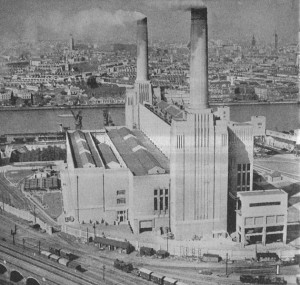In the last hundred years, the way we use energy within the home has changed considerably. One hundred years ago, people relied on coal fired power stations to produce the energy to heat their homes. The early 20th century saw spikes in total energy consumption during wartime, but otherwise it remained relatively stable.

By 1948, 22 million tonnes of coal were being burned in 27 power stations in the capital annually (House of Commons, 2013). This huge energy output was mostly for power and heating domestic households. At this time, the average Londoner used about half a tonne of coal for domestic use. But it was not to last. Burning coal contributed to the Great Smog in 1952 as well as less serious smogs. In 1956 the Clean Air Act was introduced, bringing with it a number of restrictions on domestic energy use. In some towns and cities only smokeless fuels were permitted. Oil, electricity and gas were to become more commonly used for domestic purposes in the years to come.
Household energy consumption was to increase considerably in the 1950s and 1960s. Oil replaced coal as the primary source of fuel at around the end of this time, and throughout the 1970s and 1980s this continued. While the past two decades had seen domestic energy consumption rise significantly, the increases continued, but at a less dramatic pace, throughout the 1970s and 1980s.
There were notable dips in energy consumption during the political events of the 1970s, including the recessions and Miners’ Strike. The 1973 oil crisis, a result of the Organization of Arab Petroleum Exporting Countries (OAPEC) embargo during the Yom Kippur War, and other oil shocks during the decade, also caused consumption to fall.
So total domestic energy consumption rose during this time, and continued to rise slowly but steadily throughout the 1990s and early 2000s. From 1970 to 2009, household energy use increased 0.4% a year and 17% in total (DECC, 2013). However, due to households becoming smaller throughout the last few decades, the average household energy consumption has actually fallen overall, from 22,235 kilowatts per hour (kWh) in 1970 to 18,639 kWh in 2009.
Oil, which had become so prominent in the 1970s and 1980s, was gradually succeeded by gas in the 1990s. Gas power stations were more efficient than old coal fired power stations, and gas became the primary energy source in the UK. Since 1970, household gas consumption has increased by more than three times. Solid fuel, a major energy source in 1970, has decreased from over 30 per cent to less than 2 per cent.
Gas, coal and oil still provide the vast majority of the country’s energy (90 per cent), despite focus shifts towards low carbon and renewable cheap energy such as nuclear, wind and solar power. The figure of 90 per cent is about the same as it was about 25 years ago. The remaining 10 per cent is provided by a combination of nuclear and renewable energy.
Since 2005, total energy consumption and household energy consumption have both continued to fall. Many people are becoming more aware of the need to conserve energy and the increasing number, and popularity, of energy-efficient appliances on the market plays a powerful role in our ability to cut energy consumption and carbon emissions.